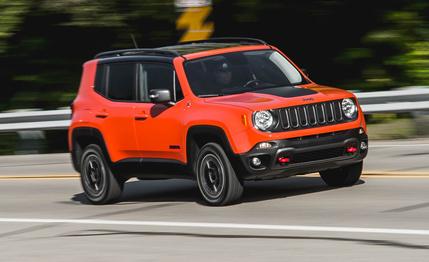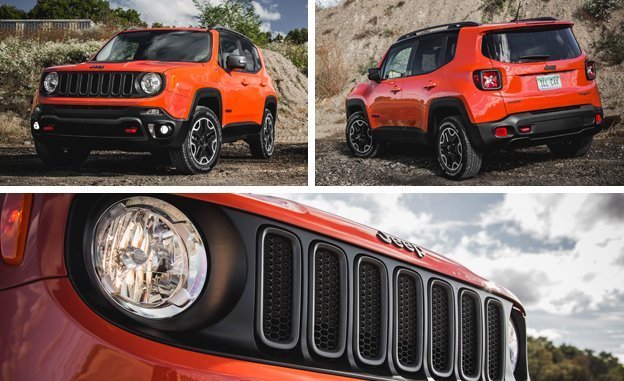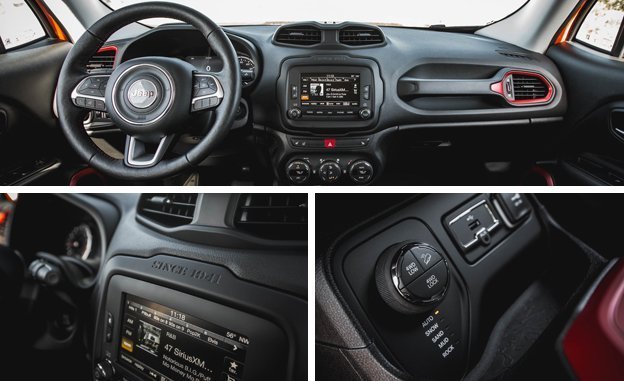 Instrumented Test
Instrumented Test
Upon hearing it’s built in Italy on a mechanical platform it shares with the Fiat 500X, one naturally wonders if the 2015 Renegade can uphold its Jeep heritage. We’ve found various charms in the Renegades we’ve tested, including a Sport with the base 1.4-liter turbo four-cylinder and a six-speed manual, an upscale Limited with the 2.4-liter Tigershark four and a nine-speed automatic, and a mid-grade Latitude that ranked third in a six-way comparison test.
Those charms—a roomy interior, cheery if cartoonish design, and surprising agility—are not notable Jeep signifiers, though. Now, we’ve finally tested what should be the Jeepiest Renegade, a Trailhawk model brandishing the “Trail Rated” badges that mean much more to the Jeep faithful than the array of themed Easter eggs the designers splashed all over the little crossover. Measured against a Wrangler yardstick, this Renegade Trailhawk comes closer to the mark than we’d expect, for both good and ill.
The Trail Rated badge declares the inclusion of useful off-road attributes including ground clearance, low-ratio gearing, a tight turning circle, long suspension travel, and the ability to ford a stream. Suggesting that there’s Wrangler DNA spliced into some of Jeep’s car-based, unit-body SUVs and crossovers, the label is a marketing gimmick to be sure, but it’s one that has earned respect among the faithful.
As for the Trailhawk moniker, the National Audubon Society recognizes no such bird by that name. Jeep invented it for a 2007 concept car based on Wrangler mechanicals because its angled headlights supposedly evoked a bird of prey. The Trailhawk came to market as a version of the Grand Cherokee, and the name currently adorns the most off-road-ready version of the Cherokee and now the Renegade. Some might prefer that “Jeep” meant something all by itself, but as the brand expands, the Trail Rated and Trailhawk badges at least help the loyalists find what they want.

Trailhawks ride 0.8 inch farther above the dirt than do other four-by-four Renegades (a total of 8.7 inches, same as a Subaru Forester) on a suspension with longer travel for more articulation. The standard powertrain is the 180-hp Tigershark four-cylinder and nine-speed automatic, along with a four-wheel-drive system using Jeep's Active Drive Low and a 4.33:1 axle ratio versus the 3.73 gear on other Tigershark-equipped Renegades. That makes for a crawl ratio in low gear of 20:1. Also included are Selec-Terrain traction management, hill-descent control, skid plates, all-terrain tires, and red-painted tow hooks. The ground clearance and amended bodywork below the bumpers improves the approach, break-over, and departure angles by 9.5, 1.7, and 2.2 degrees. The turning diameter of 35.3 feet is a foot tighter.
By Jeep’s own Trail Rated standards, the Renegade’s short, 101.2-inch wheelbase gives it an advantage over the Cherokee Trailhawk in maneuverability and approach, departure, and break-over angles. The only Jeep that beats it on both approach and break-over scores is the shorter, two-door Wrangler, and this Renegade beats all Jeep products on departure angle. When plying narrow trails or climbing obstacles, this is all for the good.
All this off-road cred makes for some tough trade-offs when it comes to on-road driving, however. Unlike the Cherokee Trailhawk with its available Pentastar V-6, the Renegade’s naturally aspirated Tigershark four feels strained when asked to move its 3581 pounds at highway speeds. At 2.4 liters—fairly large for a modern four-banger—the engine vibrates noticeably even at idle, and while it can sound powerful and enticing when exiting corners in quick succession, it’s just plain loud at sustained speed. The nine-speed tries to compensate for the shorter final-drive ratio—we saw ninth gear more often than we remember in any other FCA product with this transmission—but wind and tire noise are fairly excessive. The short wheelbase and all-terrain rubber (Goodyear Wranglers on 17-inch rims) that serve so well in the boonies make for a jarring ride quality. It’s a Jeep thing, right?

We’ve noted before that the Tigershark’s power advantage comes with a torque penalty when compared with the base 1.4-liter turbo engine, so performance doesn’t really improve. At 9.2 seconds to 60 mph and taking 17.2 seconds to cover the quarter-mile, mustering only 80 mph at the end, the Renegade is as slow as it feels. The tires also significantly hamper lateral and braking grip. The skidpad result of 0.74 g isn’t really that bad for this class, but moderately heavy understeer and the way the roll angle is accentuated by the raised suspension makes getting there an uncomfortable experience. Taking 190 feet to stop from 70 mph with some fade doesn’t build confidence.
But this is an off-roader, and people who regularly leave the pavement know there are compromises involved. Those with a Wrangler in the driveway may find such complaints overwrought—the Renegade has a usable back seat, cargo space, and a weather-sealed cabin. It’d be a pricey Wrangler Unlimited that could match those attributes. Real off-roaders, though, might share our sentiment that a manual-transmission option would make driving the Renegade Trailhawk more entertaining, particularly since the automatic remains challenged in terms of choosing the best gear and delivering consistent shift quality.
At $26,990 to start, the Renegade Trailhawk is competitively equipped. Options on this example that made on-road miles a little easier to take included a $1245 navigation upgrade that puts a 6.5-inch touch screen on the dash with Chrysler’s familiar and user-friendly Uconnect Access features. It also had a package that includes cold-weather equipment (heated front seats and steering wheel plus a wiper deicer) for $495, plus power seats, dual-zone automatic climate control, and an audio upgrade for $745. Add passive entry ($295), remote start ($200), and a hood decal ($150) and the bottom line just breaks $30,000.
The hard-core will note that 30 grand buys a more capable Wrangler, while those with an eye for all-around utility will start shopping Cherokees at that price. Even the cheapest, front-drive Renegade goes long on Jeep symbolism, but backing it up with substance demands some sacrifices of money and comfort.